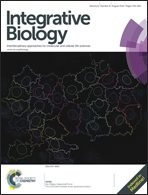Light-responsive control of bacterial gene expression: precise triggering of the lac promoter activity using photocaged IPTG†
Abstract
Light can be used to control numerous cellular processes including protein function and interaction as well as gene expression in a non-invasive fashion and with unprecedented spatiotemporal resolution. However, for chemical phototriggers tight, gradual, and homogeneous light response has never been attained in living cells. Here, we report on a light-responsive bacterial T7 RNA polymerase expression system based on a photocaged derivative of the inducer molecule isopropyl-β-D-thiogalactopyranoside (IPTG). We have comparatively analyzed different Escherichia coli lac promoter-regulated expression systems in batch and microfluidic single-cell cultivation. The lacY-deficient E. coli strain Tuner(DE3) harboring additional plasmid-born copies of the lacI gene exhibited a sensitive and defined response to increasing IPTG concentrations. Photocaged IPTG served as a synthetic photo-switch to convert the E. coli system into an optogenetic expression module allowing for precise and gradual light-triggering of gene expression as demonstrated at the single cell level.

- This article is part of the themed collection: Synthetic Biology 2012-2014

 Please wait while we load your content...
Please wait while we load your content...